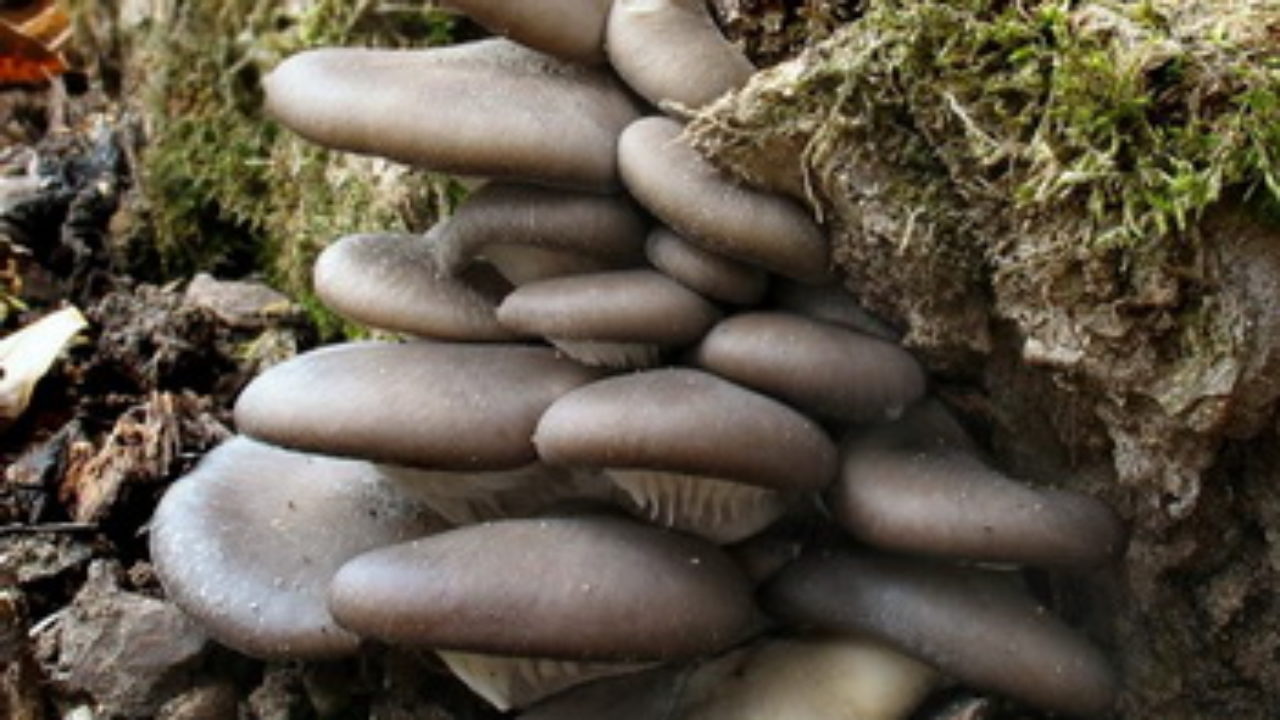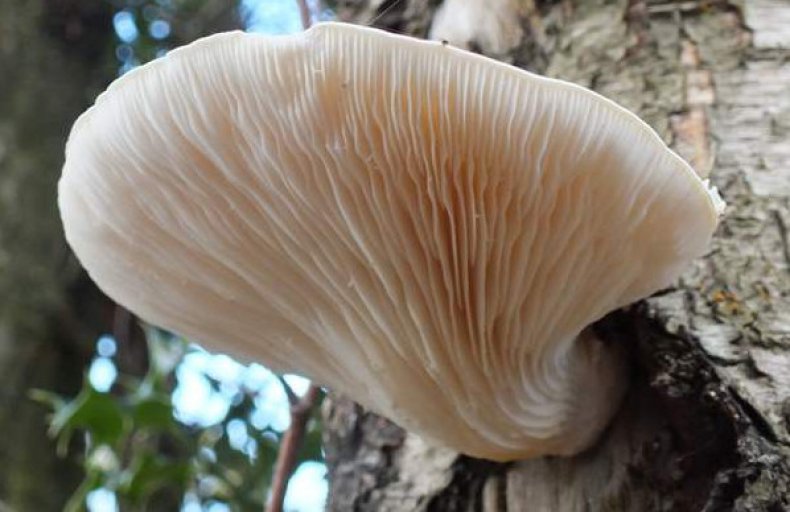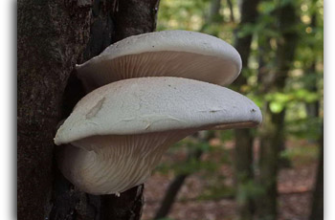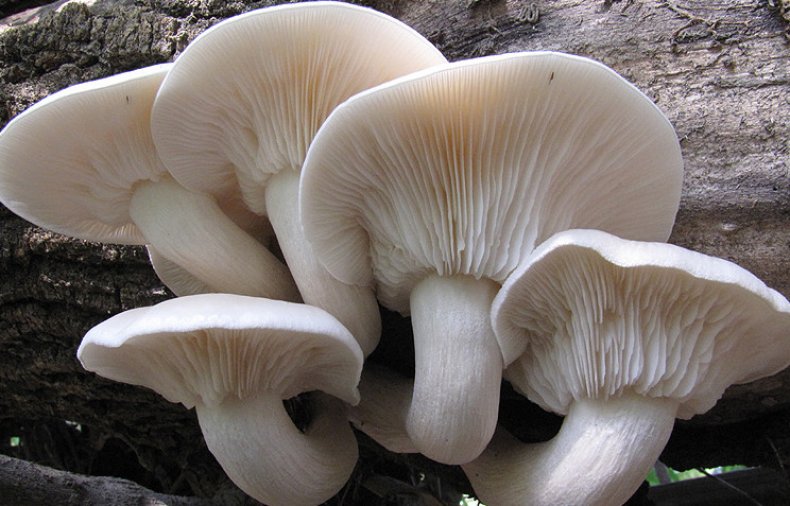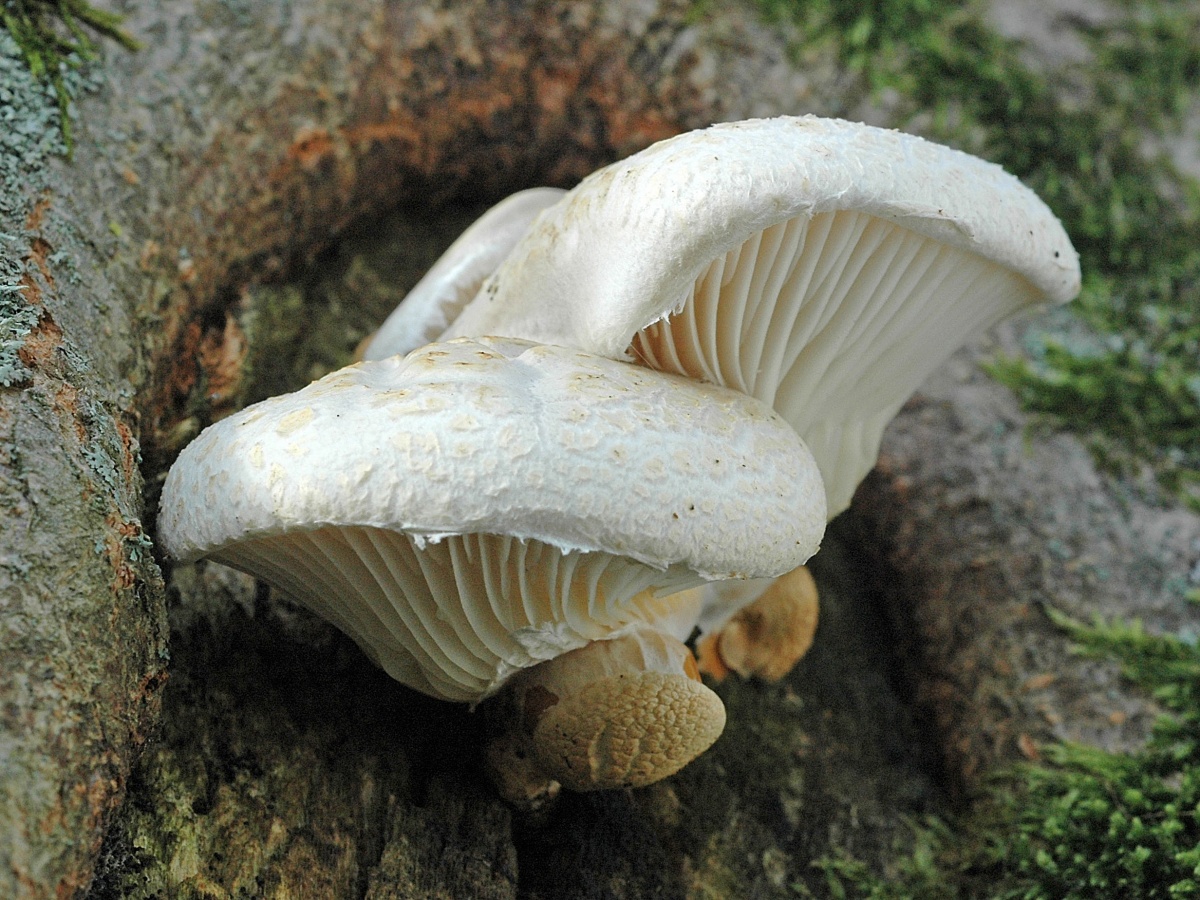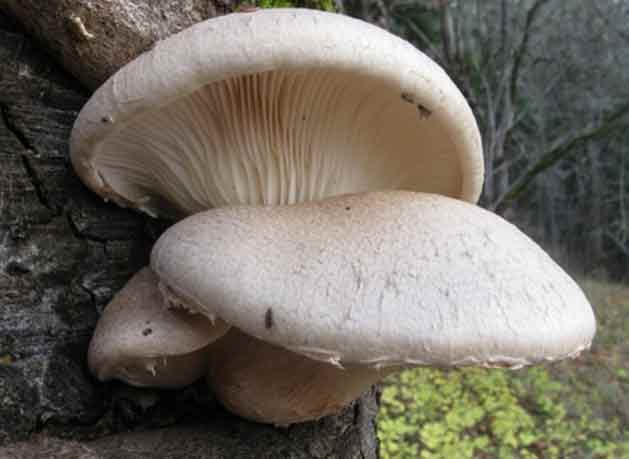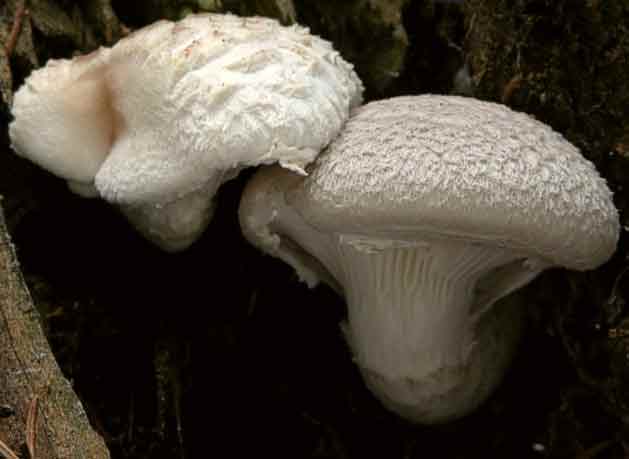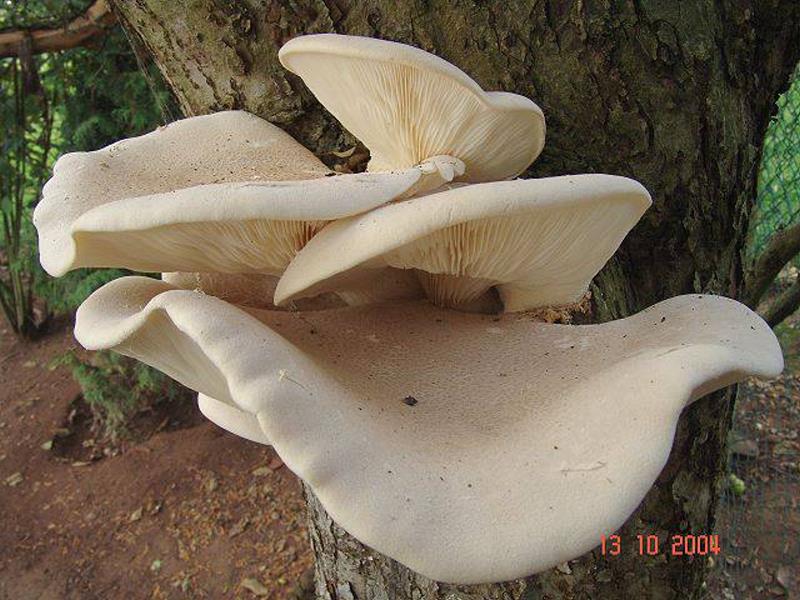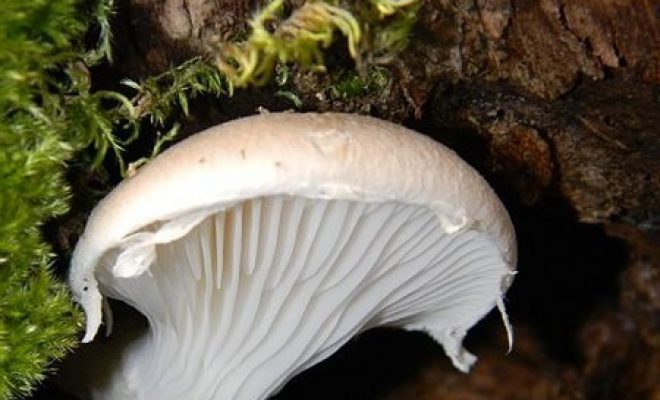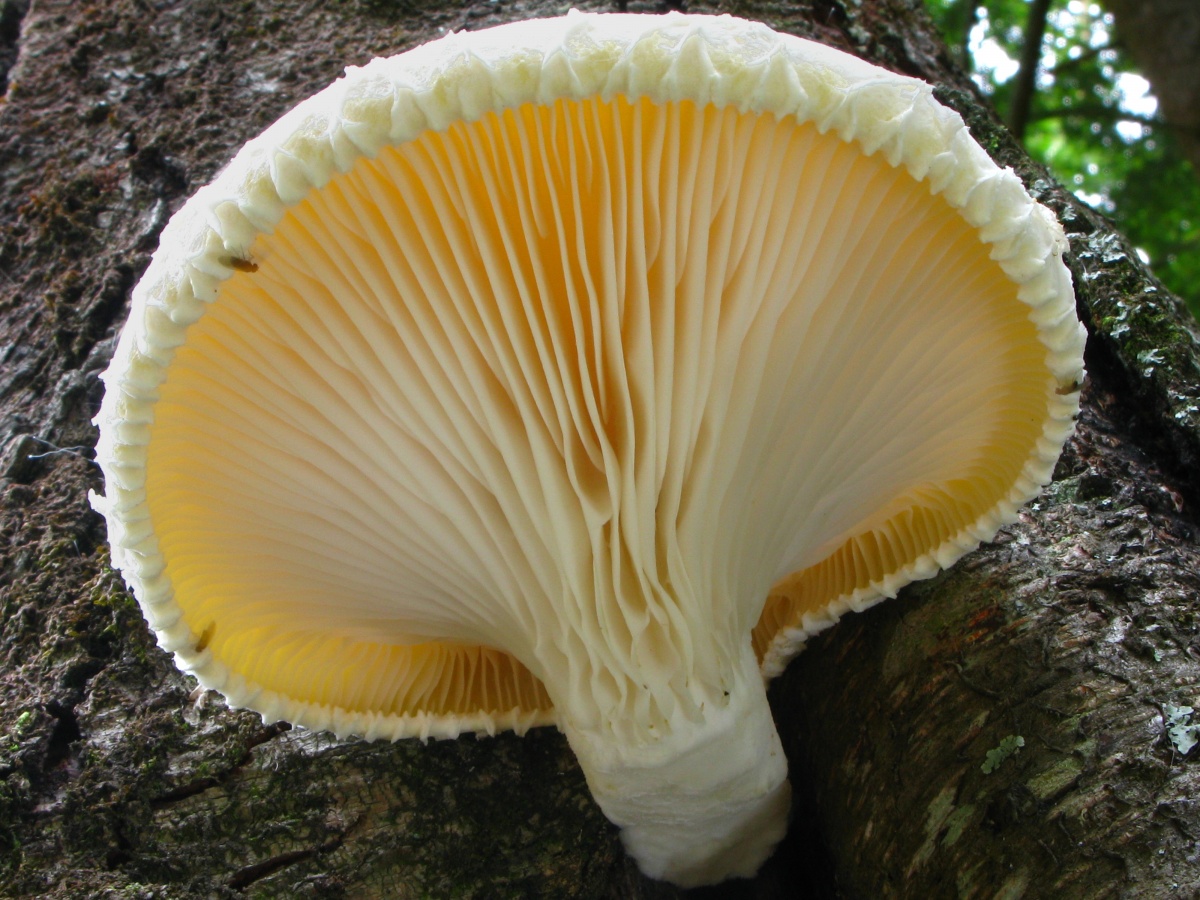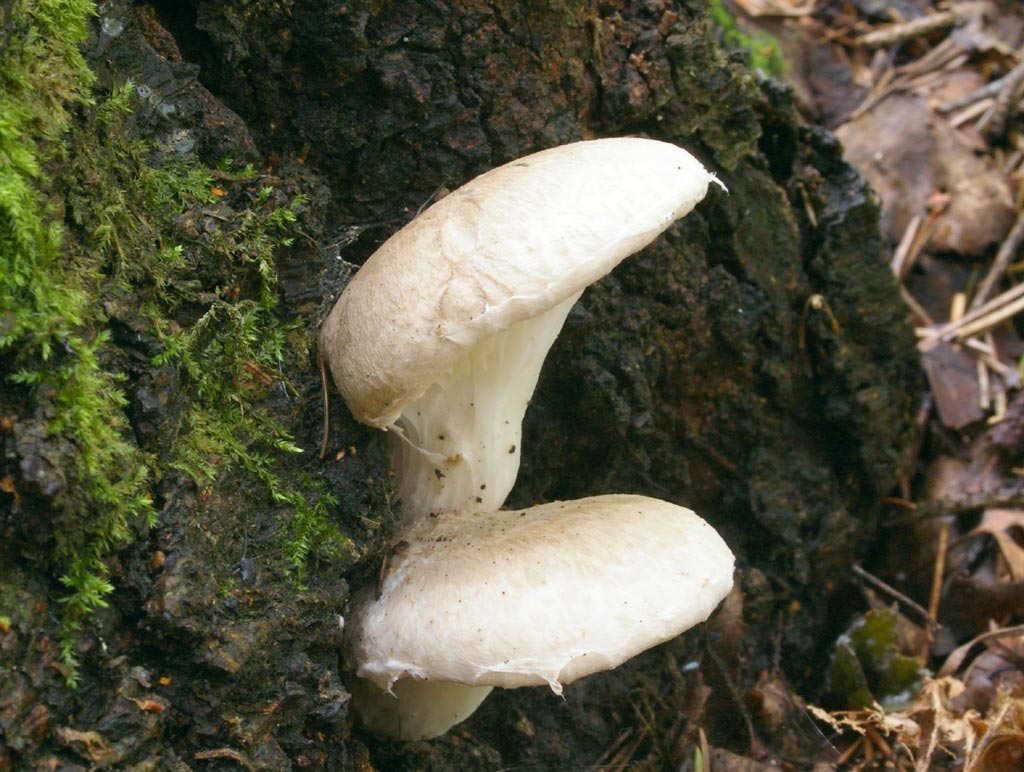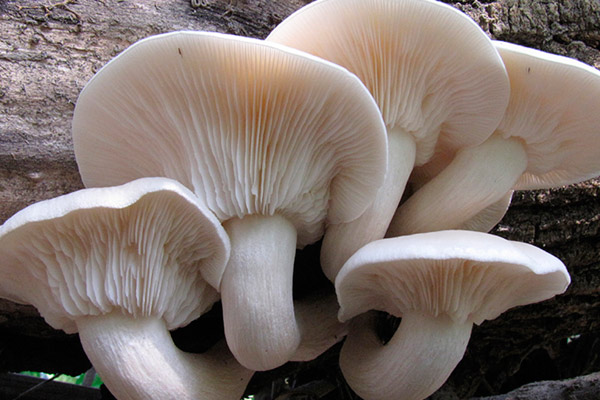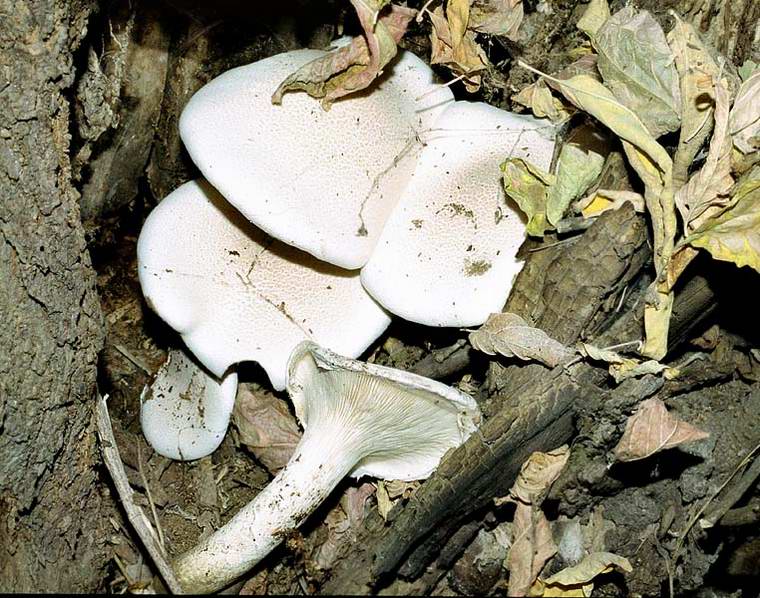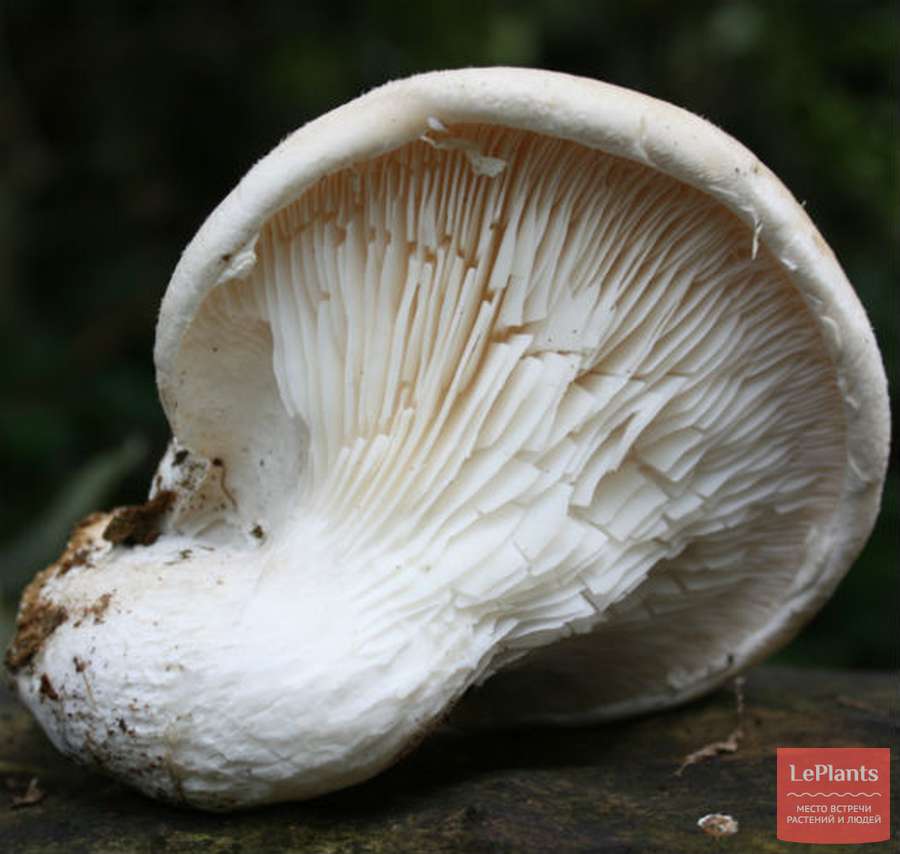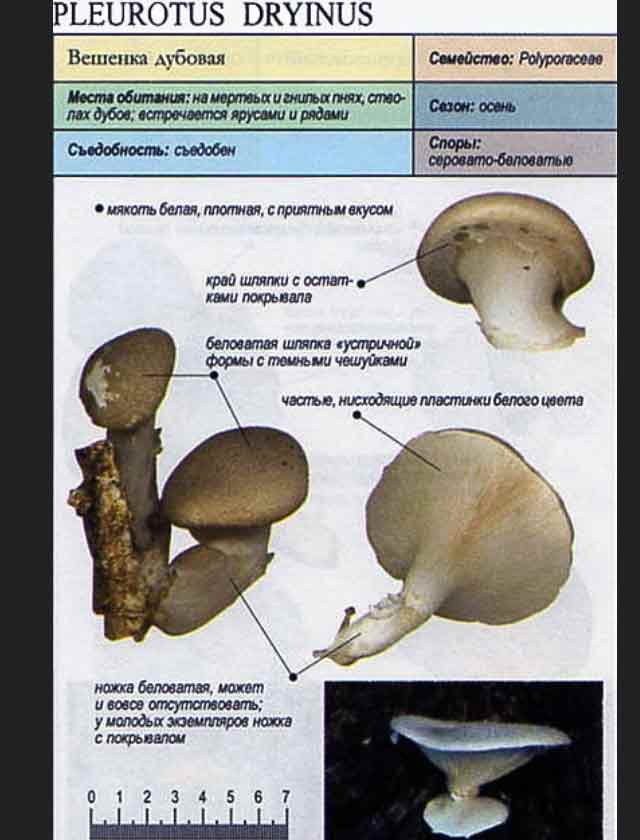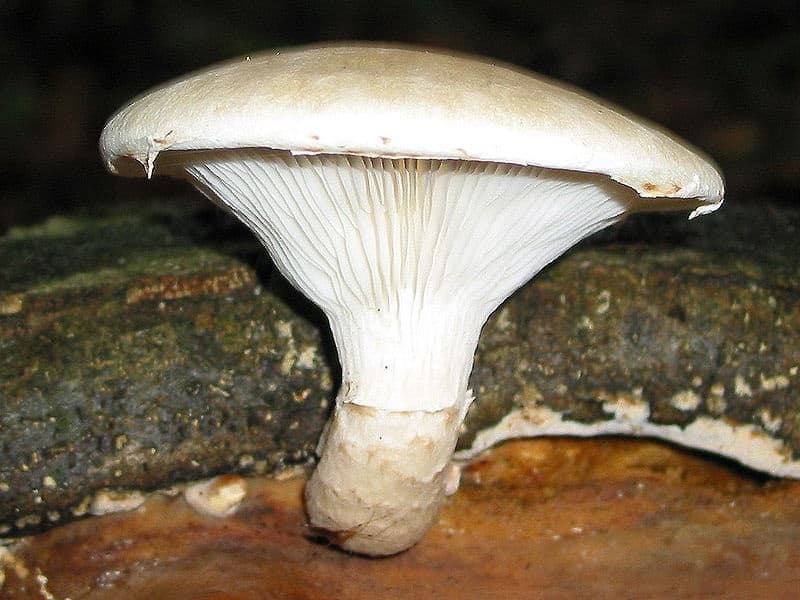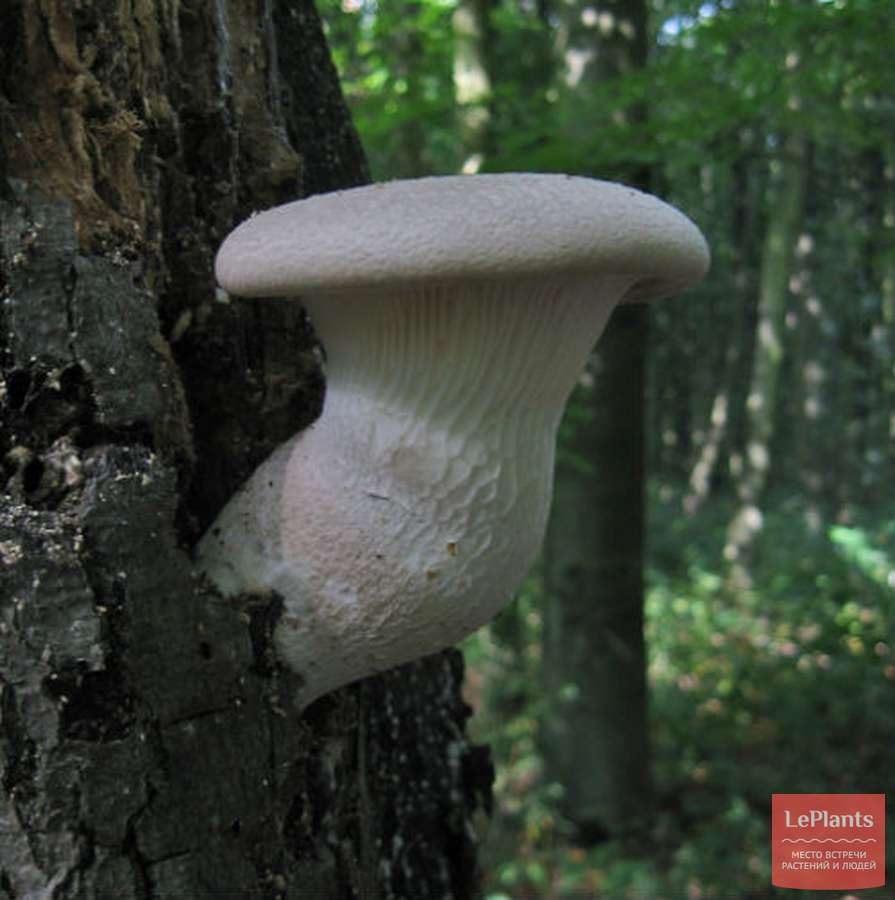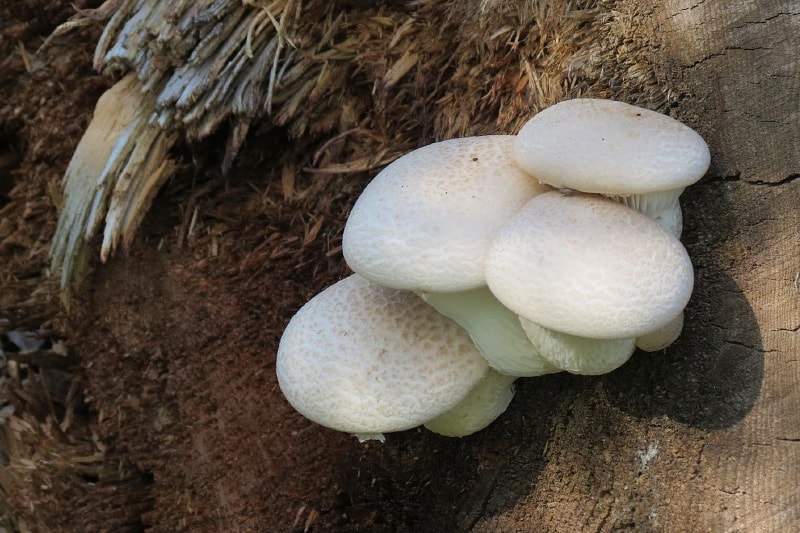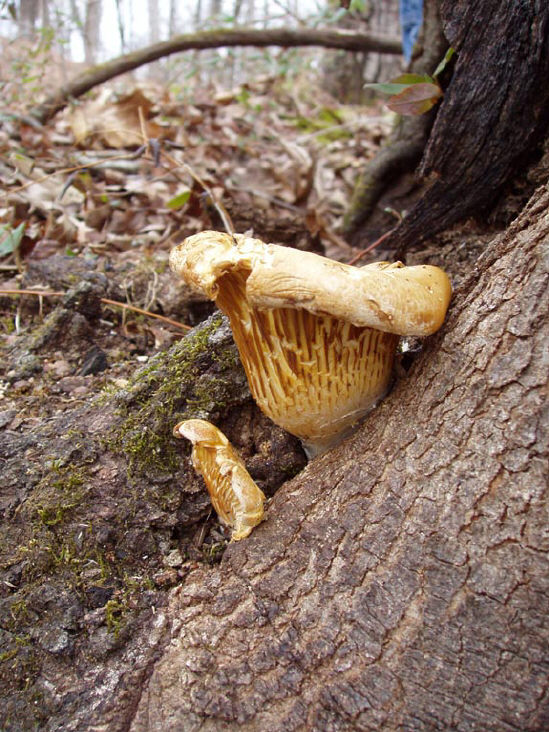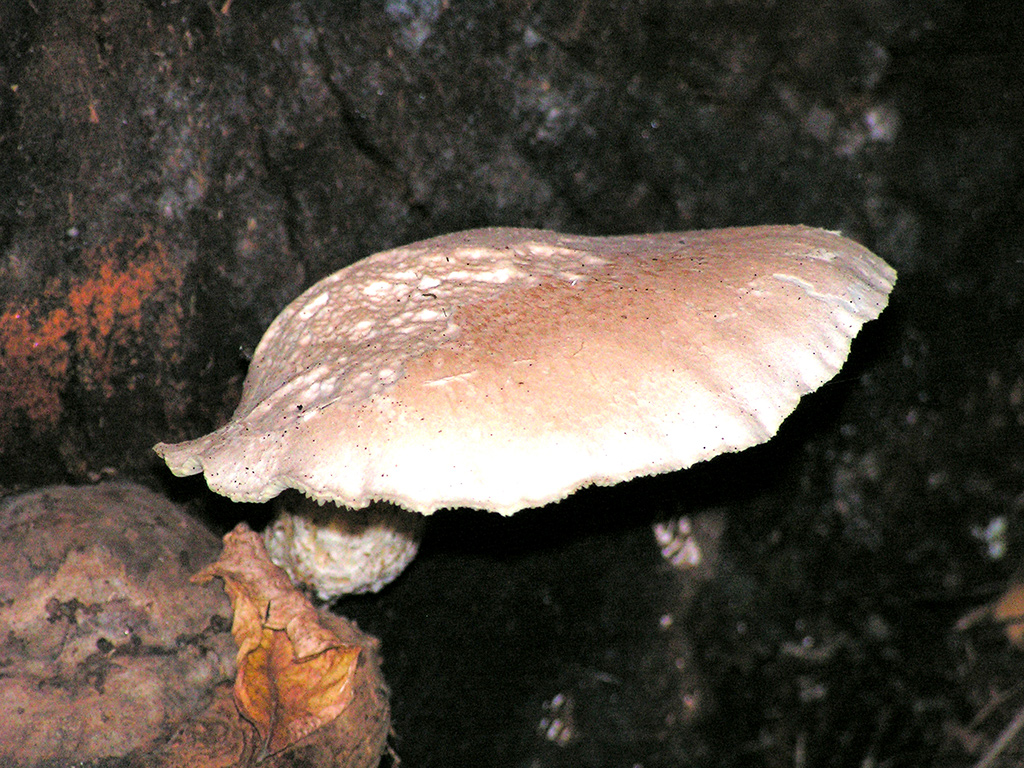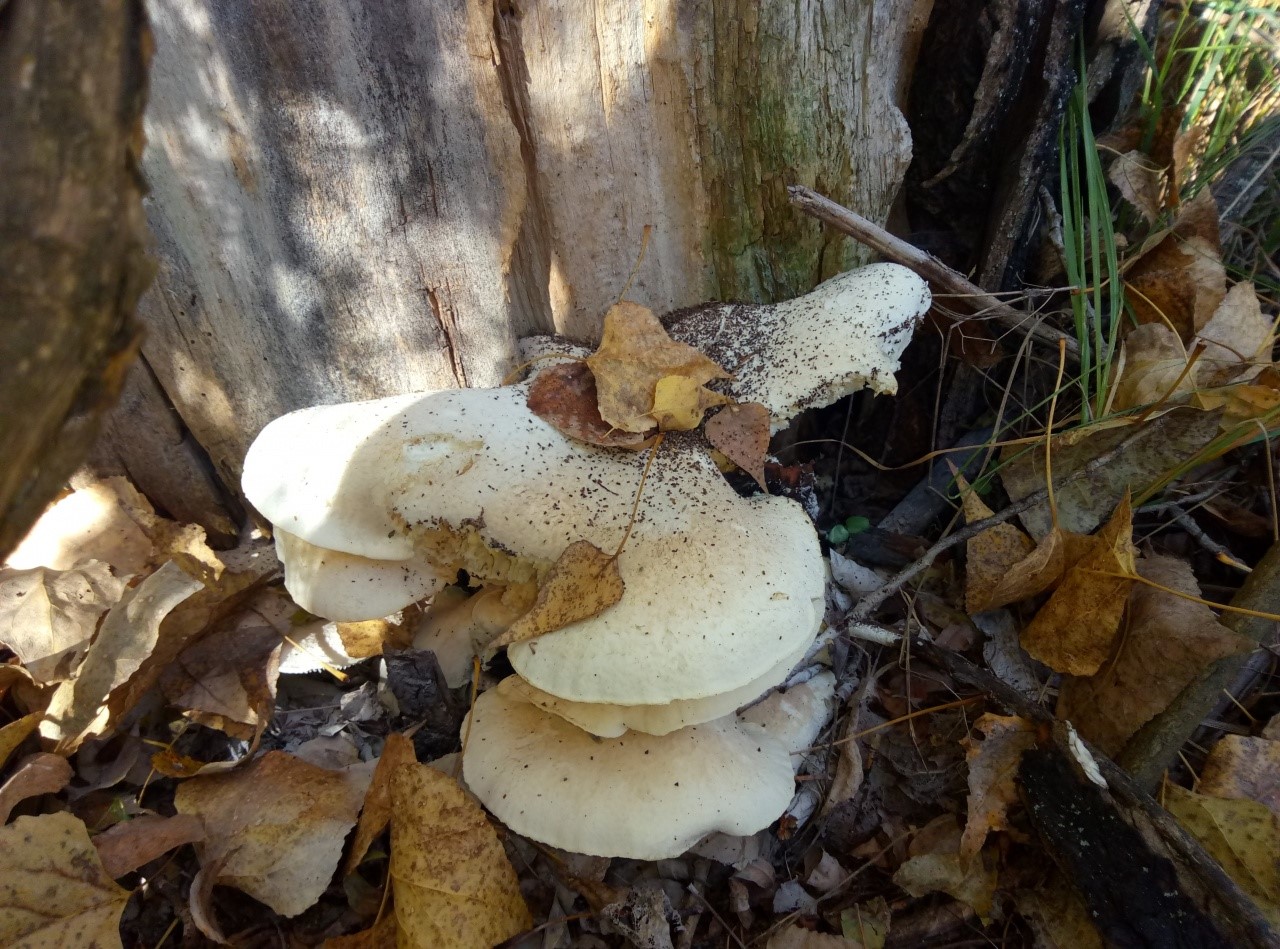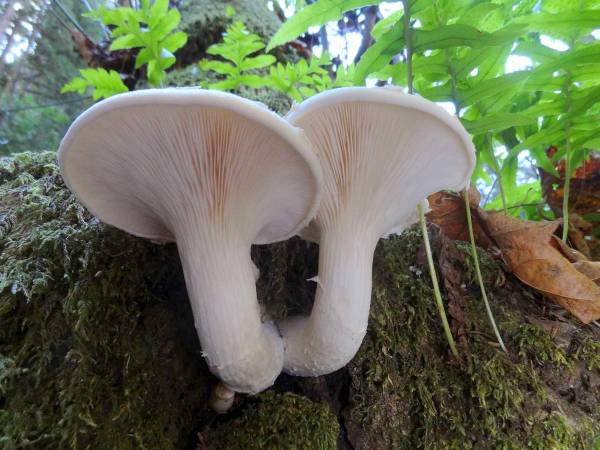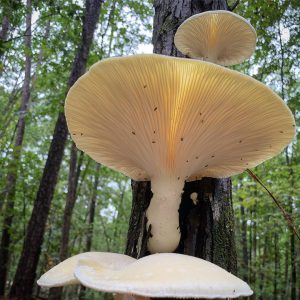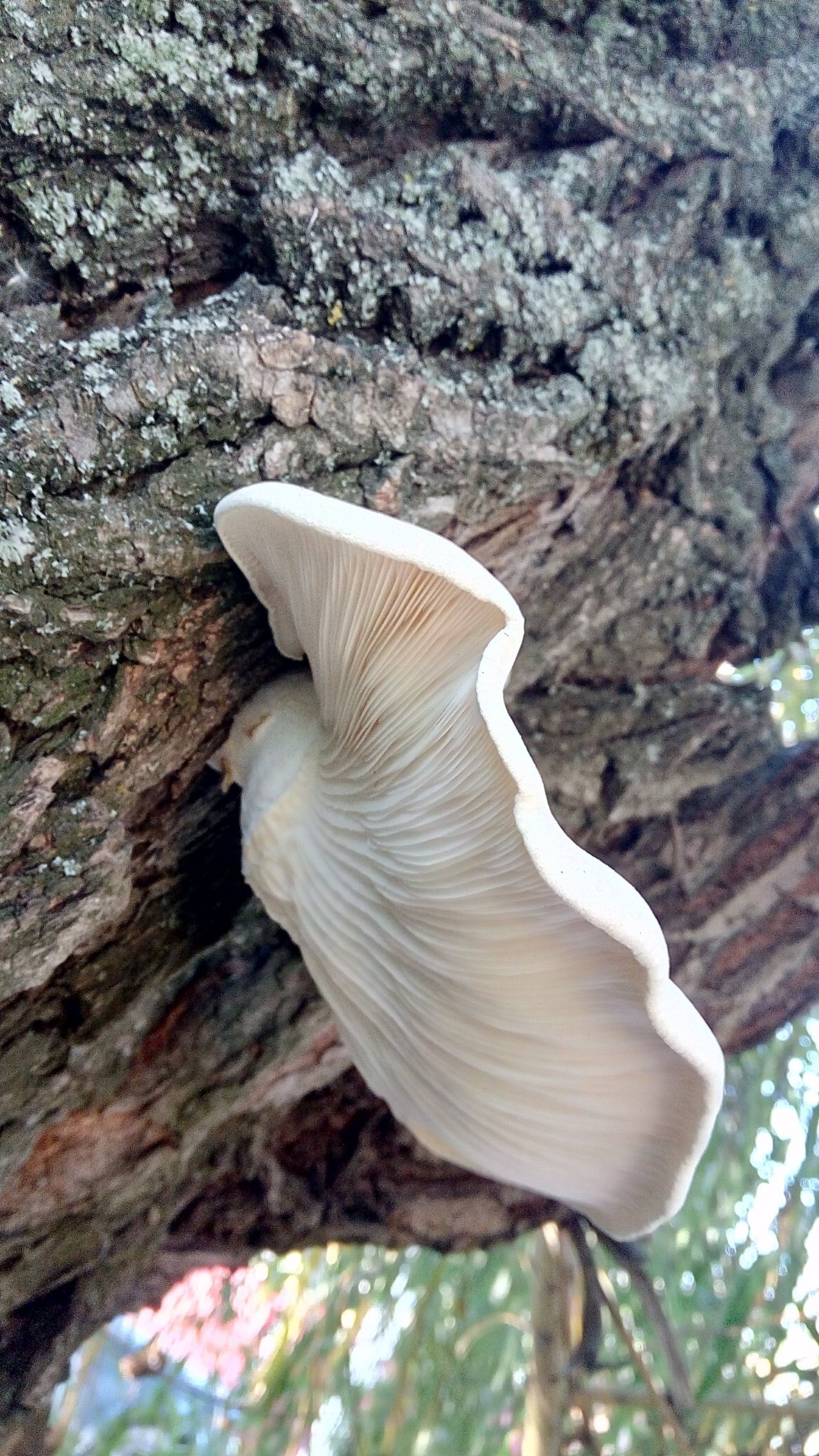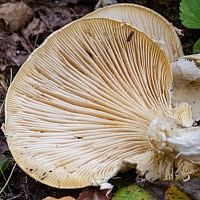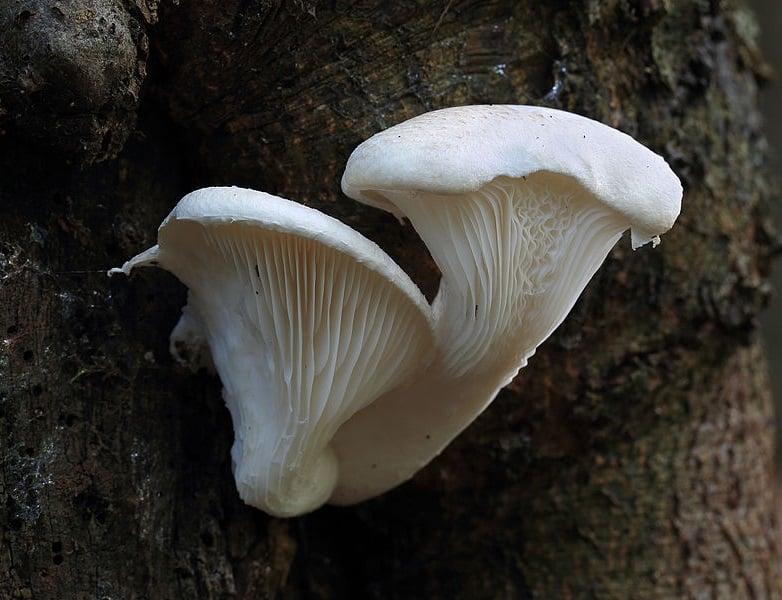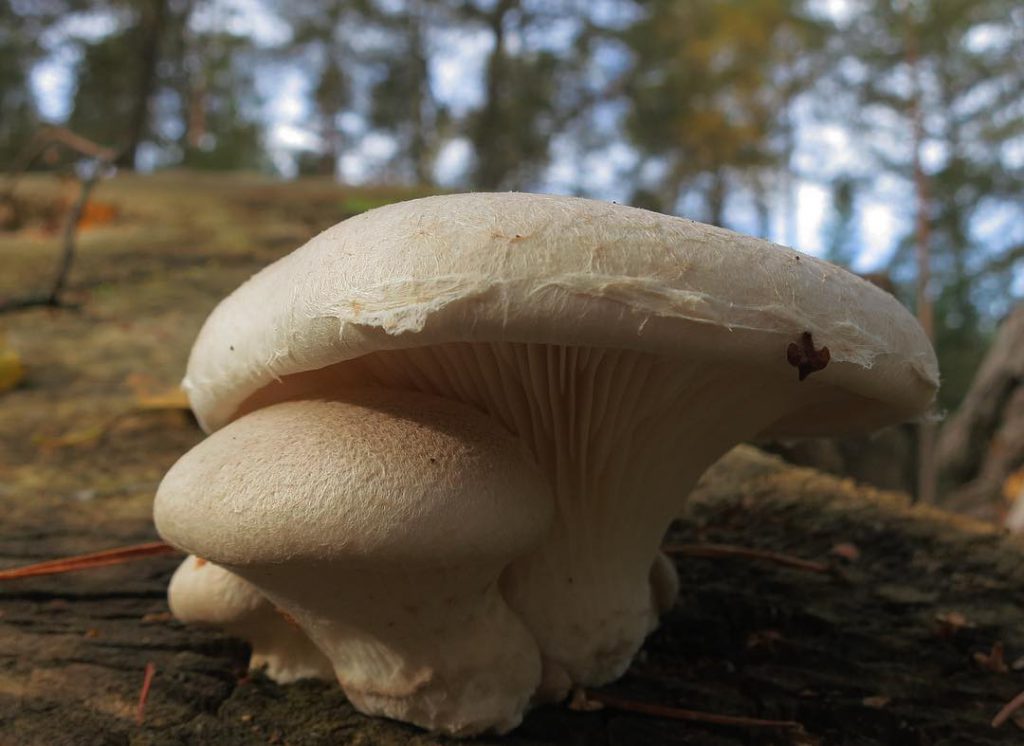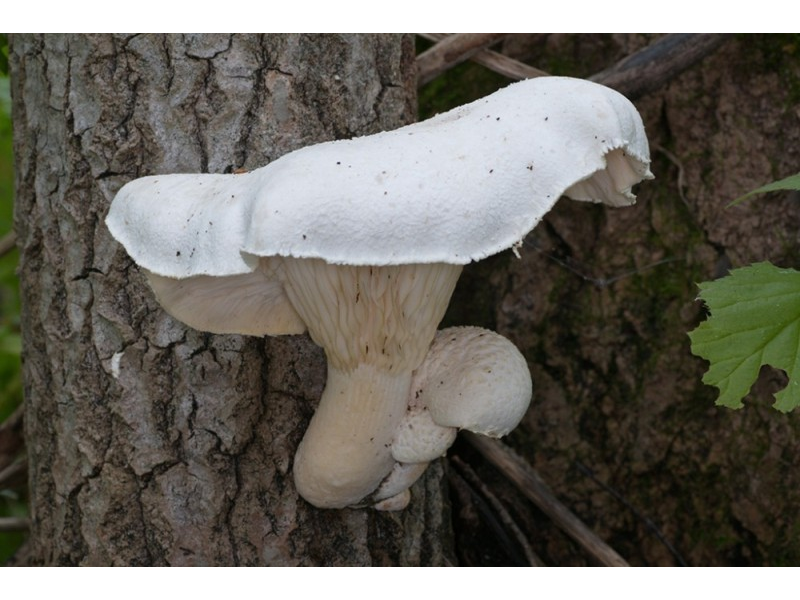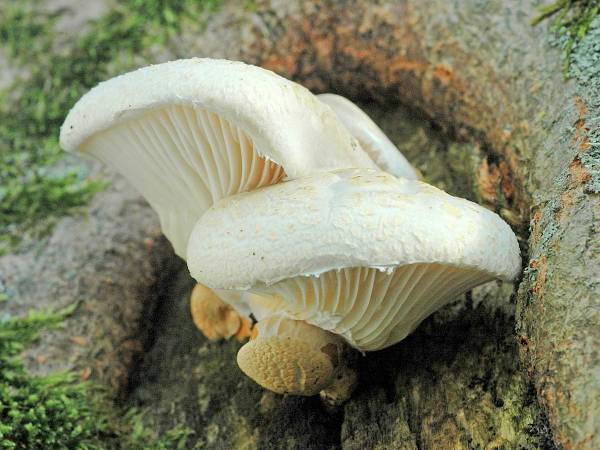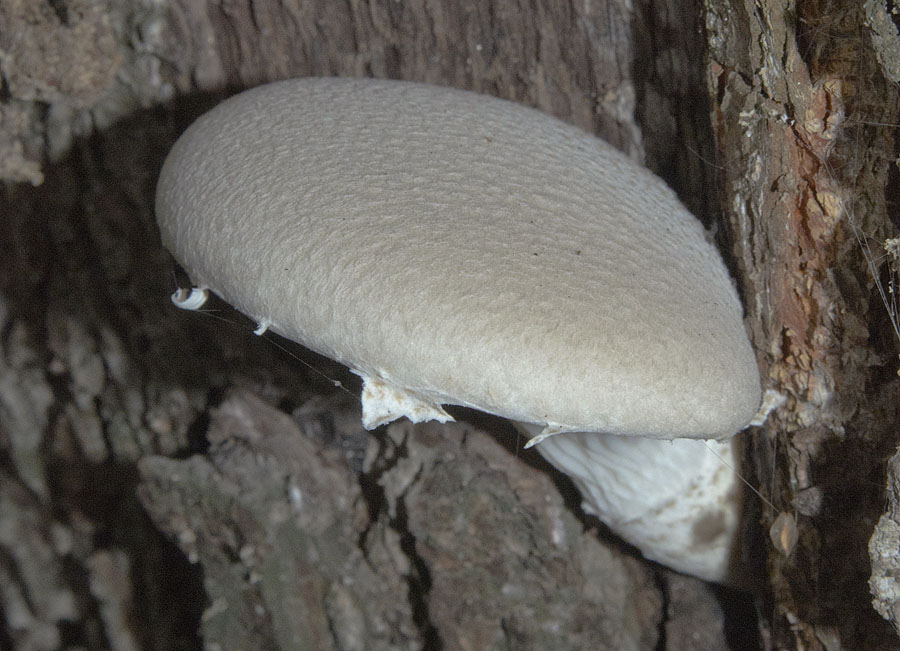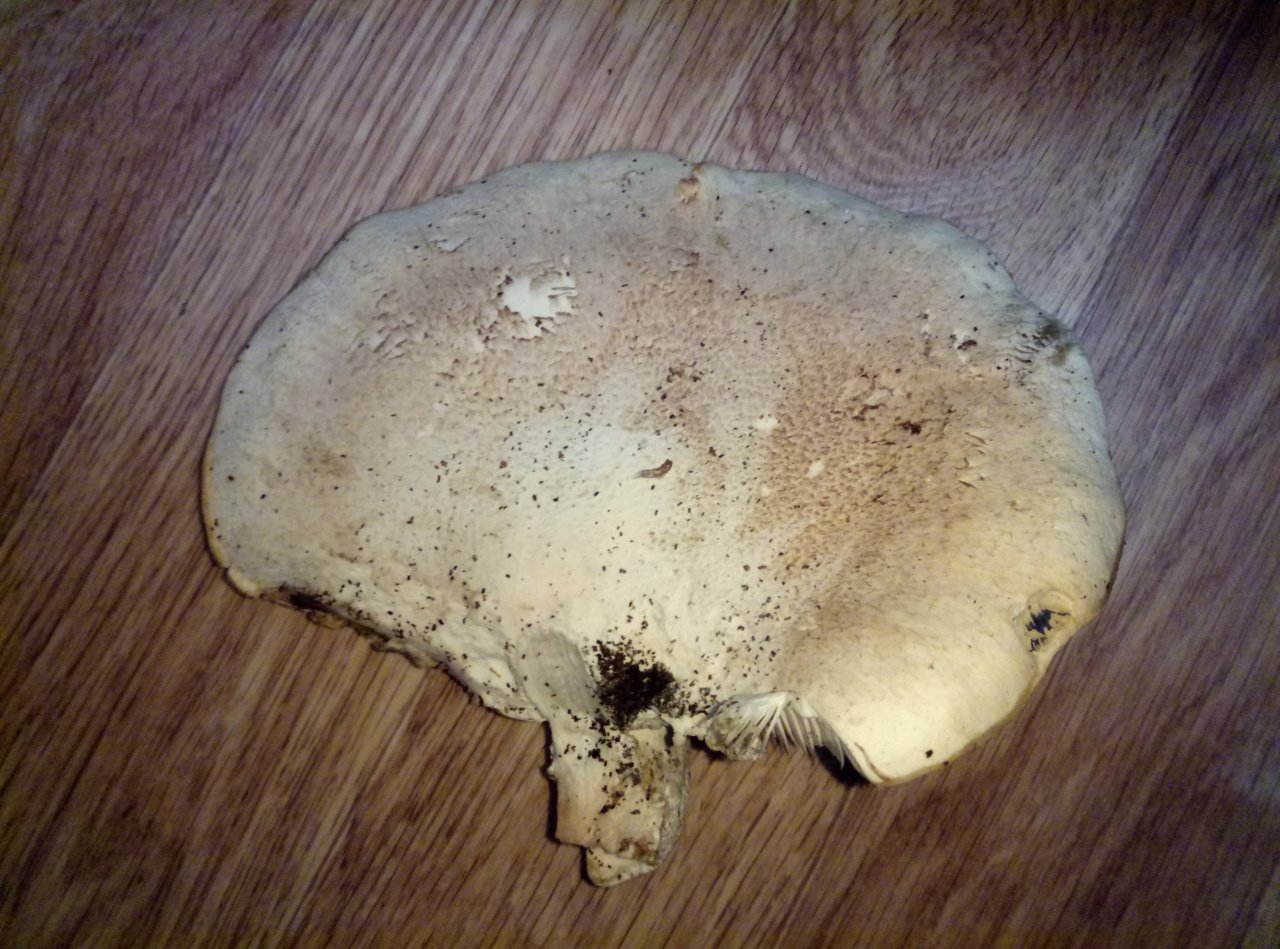Oyster mushroom (Pleurotus ostreatus)
Synonyms:
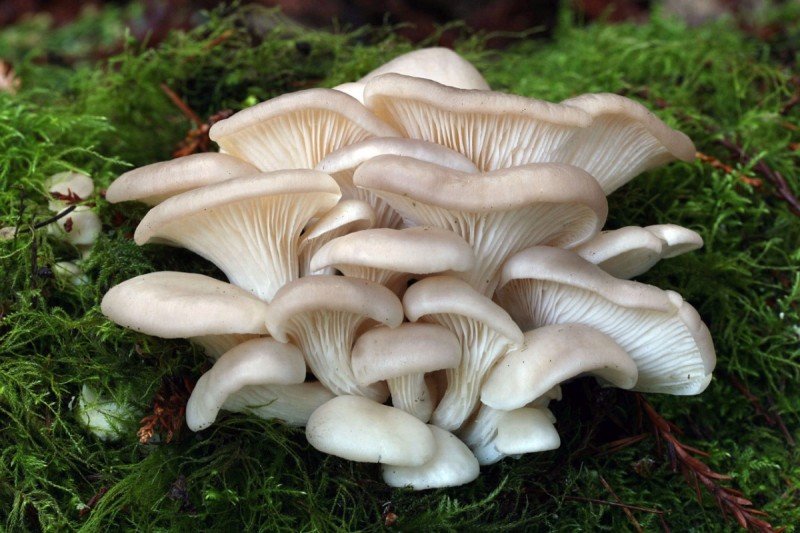
Oyster mushroom or common oyster mushroom is the most cultivated representative of the genus oyster mushroom. It is extremely convenient for cultivation due to its unpretentiousness to climatic conditions and tenacious mycelium, suitable for storage.
Oyster oyster mushroom cap: Rounded eccentric, funnel-shaped, ear-shaped, usually with rolled edges, matte, smooth, can take any shades in the range from light ash to dark gray (there are light, yellowish, and "metallic" options). Diameter 5-15 cm (up to 25). Several caps often form a fan-shaped, multi-tiered structure. The flesh is white, dense, becomes rather tough with age. The smell is weak, pleasant.
Oyster oyster mushroom plates: Descending along the stem (as a rule, do not reach the base of the stem), rare, wide, white in youth, then grayish or yellowish.
Spore powder: White.
Oyster leg of oyster mushroom: Lateral, eccentric, short (sometimes almost invisible), curved, up to 3 cm in length, light, hairy at the base. Older oyster mushrooms are very tough.
Distribution: Oyster mushroom grows on dead wood and weakened trees, preferring deciduous species. Mass fruiting, as a rule, is observed in September-October, although under favorable conditions it can appear in May. Oyster mushroom bravely fights frost, leaving behind almost all edible mushrooms, except for winter mushrooms (Flammulina velutipes). The "nesting" principle of the formation of fruit bodies actually guarantees a high yield.
Similar species: Oyster mushroom can, in principle, be confused with oyster mushroom (Pleurotus cornucopiae), from which it differs in a stronger constitution, a darker cap color (except for light varieties), a short stem and plates that do not reach its base. Oyster mushroom is also distinguished from whitish oyster mushroom (Pleurotus pulmonarius) by its dark color and more solid structure of the fruiting body; oak oyster mushroom (P. dryinus) - lack of a private bedspread. Inexperienced naturalists may also confuse oyster mushroom with the so-called autumn oyster mushroom (Panellus sirotinus), but this interesting mushroom has a special gelatinous layer under the skin of the cap that protects the fruiting body from hypothermia.
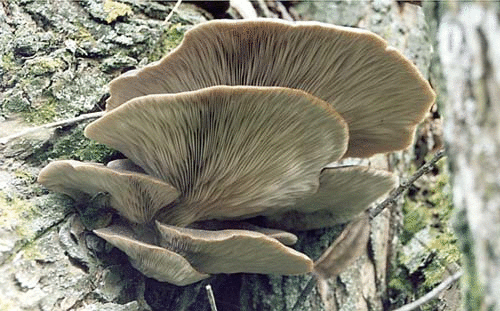
Edible: The mushroom is edible and even tasty when young. Artificially cultivated (whoever goes to the store saw it). Elderly oyster mushrooms become tough and tasteless.
Video about oyster mushroom:
Author's notes: Surprisingly, but true: I first encountered the most common oyster mushroom only when I myself wanted it. Deliberately collided. I remembered in early September that I had never actually seen oyster mushroom in the field (shame!), And went in search of
I had to search for a long time: only on the way back, passing by a huge broken willow growing (or rather, rotting) at my gate, I noticed the strange gray "ears" defiantly bulging on the chopped trunk ...
Unlike its nondescript counterparts, oyster mushroom made a very serious impression on me. It does not look like a dried pig's ear, or a swollen overgrown chanterelle. Heavy "nests" that do not disintegrate during collection, large cozy burdocks of caps, dense white flesh, homerically huge worms ... all these signs set you up for a serious mood. Indeed, not every mushroom knows how to present itself in such a way that you want to grab a whole "nest" (with both hands, you can't drag it off with one) and carry it to show your neighbors - as I actually did.
And oyster mushroom nests can cleverly wriggle out from under the knife and fall with all their weight on the head of a hurried collector, without splitting at all.
Oyster mushroom (Pleurotus dryinus): description and photo
| Name: | Oyster mushroom |
| Latin name: | Pleurotus dryinus |
| Type of: | Conditionally edible |
| Specifications: |
|
| Systematics: |
|
Oyster mushroom is a rare conditionally edible mushroom of the Oyster mushroom family. In several regions of Russia it is included in the Red Book.
Where does oak mushroom grow?
Despite its name, it settles not only on the remains of oak trees, but also on the dead wood of other deciduous trees, for example, elms. Mushrooms are found in mixed and deciduous forests of the temperate zone of the European continent. Grows singly or in intergrowths, often multi-tiered, can completely cover a dead tree.
Description and photo of oak oyster mushroom is presented below.
What does oyster mushroom look like?
The cap has a shell-shaped or fan-shaped, convex or concave-prostrate shape. It reaches 5-10 cm in diameter, sometimes 15 cm. The edge curls inward. The surface is smooth, with compressed scales, whitish, cream, gray or brownish shades. The pulp is light, elastic, thick, has a pleasant smell of mushrooms.
This mushroom grows singly or grows together by roots in small bundles
The plates are rather wide, frequent, branched, descending. Their edge is even, wavy or finely toothed. The color is lighter than that of the cap, acquires a yellowish tint with age. Covered with white or light gray bloom. Spore white powder.
The height of the leg is from 3 to 5 cm, the thickness is from 1 to 3 cm. It is eccentric, short, tapering towards the base. The color is like that of the cap, sometimes a little lighter. The pulp is yellowish, closer to the root, tough and fibrous.
A young oak oyster mushroom has a blanket on the plates. It quickly breaks and turns into white and brownish patches on the cap and a torn flaky ring on the stem.
Is it possible to eat oyster mushroom
Considered conditionally edible. In some foreign sources, it is described as an inedible species, in others - as a mushroom with good taste.
False doubles
Oyster mushroom, or ordinary. This species has a similar fruiting body shape, size and color. Its main difference is the absence of a blanket on the records. Stem short, eccentric, lateral, curved, often invisible, hairy at the base, very stiff in older specimens. It belongs to edible, grown on an industrial scale, the most cultivated species among oyster mushrooms. Unpretentious, adapts well to adverse conditions. Active growth is observed in September-October, it can start bearing fruit even in May. High productivity is ensured by the fact that the fruit bodies grow together, forming the so-called nests.
Oyster mushroom, grown in artificial conditions, can be bought in any supermarket
Oyster mushroom pulmonary (whitish, beech, spring). The color of this mushroom is lighter, almost white. Another important sign is the absence of a filmy bedspread. The leg is lateral, less often central, hairy at the base, off-white. Treats edible. It grows from May to September on decaying wood, less often on living, but weak trees. Under good conditions, it grows into bundles with bases. It is not common.
Oyster mushroom is white
Collection rules and use
You can harvest oyster mushrooms from July to September.
It is quite rare, there is little information on taste. It is believed that this one is not inferior in taste to its widespread relative - the oyster (ordinary). You can fry, stew, dry, make soups and sauces.As a rule, only hats are eaten, since the legs have a fibrous structure and are stiff.
Boil in salted water for 20 minutes before cooking. It is not recommended to salt or pickle for long-term storage as canned food.
Conclusion
Oyster mushroom is a rare conditionally edible mushroom. Its main difference from other related species is the presence of a veil on the spore-bearing layer, which breaks apart in adult specimens and presents itself as flake-like remains.
Popular and common
Customers who come to the supermarket for mushrooms are the first to be greeted by Oyster mushrooms. They literally flooded retail outlets. Many private entrepreneurs, large mushroom farms have mastered the method of artificially growing these mushrooms. They are prolific and unpretentious. However, the cultivated Oyster mushroom significantly loses to the varieties that grow in nature in taste, it has almost no characteristic mushroom aroma.
For amateurs who are not versed in mushrooms, Oyster mushrooms are ideal. They are edible and tasty, poisonous counterparts do not exist in nature. For beginners, it is enough to study the photos and names of varieties of Oyster mushrooms - and it's time to go on a quiet hunt. Do you want to know exactly what kind of mushroom you met in the forest? Then carefully read the description, the mushroom encyclopedia contains detailed verbal portraits of mushrooms, valuable information about the beneficial properties, methods of preparation.
Once in a forest or park, inspect the trunks of living and fallen trees, stumps and dead wood. Oyster mushroom is a common tree fungus that grows even in gardens on weakened, diseased fruit trees. Finding a whole family is a matter of time, do not rush, be careful, the patient mushroom picker will receive a reward. Edible mushrooms in the trees are good luck for the gatherer. Almost all types of Oyster mushrooms grow in large families weighing from 1 to 3 kg. When a lucky mushroom picker finds one of them, a full frying pan of delicious fried mushrooms awaits. Do not be alarmed when you come across pink, orange, olive, yellow mushrooms on tree trunks, these are edible varieties of Oyster mushrooms.
Description
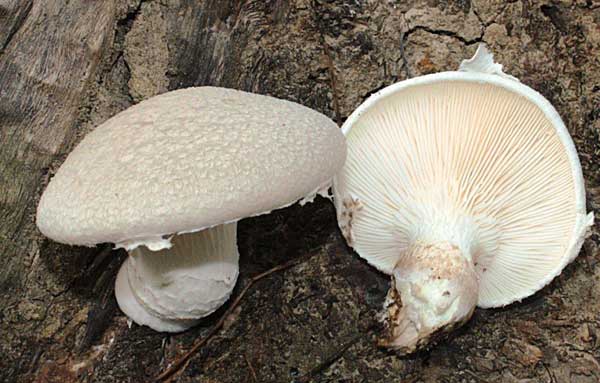
Oyster mushroom (Pleurotus dryinus) is edible, belongs to the Oyster mushroom family. It is marked by the following species characteristics:
- the cap is "oyster" in shape, with a turned-up edge, convex at first, becomes flatter as it develops. The color is whitish, it can acquire a more or less pronounced light brownish tint. The surface is rough, with small scales that become darker and more noticeable with age. Hat diameter up to 10 cm;
- the descending plates are rather frequent, colored lighter than the cap and stem. With age, they acquire a yellowish tint. In young mushrooms, the plates are completely covered with a light protective cover. Remnants of this cover persist into adulthood;
- spores are grayish-white;
- a stiff, eccentric leg at the base, often lateral, very short or completely absent; on average, its dimensions are up to 5 cm in length, 1-3 cm in thickness. Coloring coincides with the tonality of the cap, but it can be slightly lighter; dense, scaly, with rapidly disappearing veil;
- light, dense, fleshy pulp with a light mushroom smell, pleasant to the taste.
Cooking recipes
Oyster mushroom is easily processed for cooking various dishes.
Cleaning
Mushrooms are filled with water for 15–20 minutes. They are removed from the container with the removal of adhered debris. With the help of a thin sharp knife, dried and spoiled places are removed, the roots are removed. The peeled mushrooms are washed again.
Cooking
Mushrooms are placed in cold water, salt is added. When cooking oyster mushrooms, juice is abundantly released, so the water should barely cover the mushrooms. You can add a little pepper and a clove of garlic. Boil the mushrooms for 15-20 minutes over medium heat. With the help of a colander, allow excess liquid to drain over the sink. Oyster mushrooms are cooked!
Pickling
 The recipe allows you to pickle mushrooms in just 8 hours.
The recipe allows you to pickle mushrooms in just 8 hours.
You will need:
- fresh oyster mushrooms - 1 kg;
- sugar - 2 tbsp. l .;
- salt - 1 tsp;
- onions - 2 large heads;
- garlic - 2 cloves;
- vinegar 9% - 30 ml;
- water - 0.5 tbsp.
Washed mushrooms are cut into pieces, small oyster mushrooms are left intact. Cook in salted water for 15 minutes while preparing the marinade. Stir salt, sugar until dissolved, add vinegar and put chopped chives. Peeled onions are cut into thin half rings, crumpled for juicing.
Put half the onion in a prepared pickling container, with a layer of oyster mushrooms on top. It is poured with marinade, covered with the remaining onion and pressed down by oppression. The further cooking process continues in the refrigerator.
Freezing
Peel and rinse the mushrooms, place on a paper towel, cut into small pieces and dry on the towel again. Place oyster mushrooms on a flat surface and place in the freezer for 4 hours. This action will prevent the mushrooms from sticking together. Transfer to bags and return to the freezer.
Frying
Peeled oyster mushrooms are cut into pieces, laid out in a pan with heated sunflower oil. Add salt and fry until all the liquid has evaporated.
Salting
You will need:
- rock salt - 60 g;
- carnation - 3 buds (inflorescences);
- garlic - 3 cloves;
- dill sprigs with umbrellas - 2 pcs.;
- bay leaf - 1 leaf;
- allspice - 4 pcs.;
- black pepper - 4 pcs.;
- filtered water (for brine) - half a liter.
The legs are separated, leaving a centimeter-long part of the base for the cap. Blanch for about 7 minutes and drain. In dry sterilized jars, the caps are laid out in dense layers.
To prepare the brine, rock salt is poured into boiling water (0.5 liters), peppers, cloves, laurel are added. leaf, sprigs of dill, peeled whole chives. Boil for 7 minutes and filter the brine. Poured into jars and closed with nylon lids. After a week, the product is ready for use.
Canning oyster mushrooms for the winter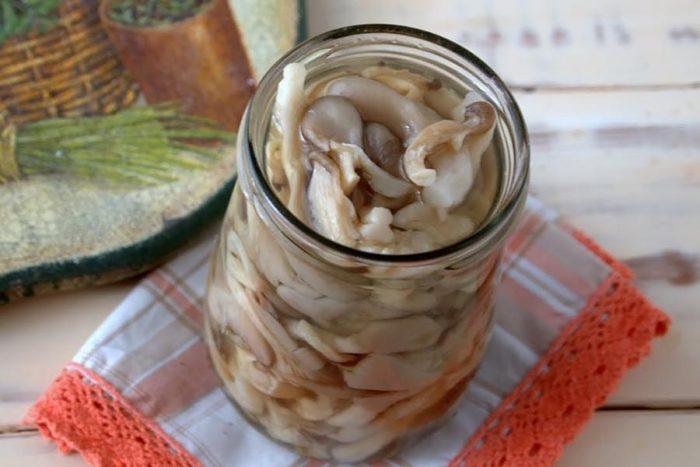
Would need:
- oyster mushrooms - 500 g;
- champignons - 500 g;
- large carrots - 2 pcs.;
- garlic - 3 cloves.
Mushrooms are boiled for 8 minutes, adding salt to the water. Allow to drain through a sieve. Larger mushrooms are divided into parts, carrots are rubbed on a fine grater and mixed with mushrooms. For the marinade, pour 4 tablespoons of vegetable oil into the pan, add 1 tsp. chopped paprika, ¼ spoon chopped black pepper, red pepper to taste. All ingredients are quickly fried. Finely chopped garlic is added to mushrooms with carrots, 3 tbsp. l. vinegar. You can add a little sugar, spices are poured into a container with mushrooms. After mixing, they are poured into jars.
Each individual type of mushroom has its own individual composition and taste, appearance. Oyster mushroom is widely used in the preparation of delicacies and is valued for its useful qualities.
Places of growth oak oyster mushroom
Although this oyster mushroom is called oak, it bears fruit on the remains of a variety of trees. They are harvested from July to September, at the same time when the pulmonary oyster mushroom bears fruit.

Distinctive features of oak oyster mushroom
Oak mushroom can be recognized by its characteristic private bedspread. It is on this basis that oak oyster mushroom can be easily distinguished from oyster and pulmonary oyster mushrooms.
Evaluation of the edibility of oak oyster mushroom
In foreign literature, oak oyster mushroom appears as an inedible mushroom, but in certain sources it is noted that it has good nutritional qualities. However, this type of mushroom is not widespread, so it is difficult to judge its taste.

Properly cooked oyster mushrooms taste no worse than their forest relatives - boletus, boletus and porcini mushrooms. Oak oyster mushrooms, like other varieties of oyster mushrooms, are universal, they can be stewed, salted, boiled, fried, pickled, made sauces and soups from them. Oyster mushroom goes well with poultry and meat.
It should be noted that oyster mushrooms cannot be stored for a long time. Cook them quickly, they don't need pre-cleaning like many other types of mushrooms.Oyster mushroom caps are mainly used for food, and the legs are used less often, since they are fibrous and more rigid. But the legs can be finely chopped, and then they will become more tender. If oyster mushrooms complement the dishes, then they are added almost at the end of the cooking process.

When boiling oyster mushrooms, they are cut and dipped in salted, boiling water, after which they are boiled for about 20 minutes. Before pickling, they are boiled with spices and vinegar for 25 minutes. Like other mushrooms, oyster mushrooms go well with onions. When frying, you can use vegetable and butter. Fried, boiled or pickled mushrooms are added to salads.
The benefits of oyster mushrooms for the body.
Oak oyster mushrooms contain a large amount of polysaccharides, due to which they are considered an anti-cancer product. These mushrooms have an immunomodulatory effect, therefore they are detrimental to benign and malignant neoplasms. It is recommended to consume oyster mushrooms after chemotherapy or when exposed to radiation. These mushrooms remove toxins from the body. Today, on the basis of oyster mushrooms, a large number of medicines have been developed to fight cancer cells.

Oyster mushrooms contain almost all B vitamins, vitamins C, E, PP, iodine and iron. They are also rich in essential amino acids, digestible proteins, monounsaturated fats and minerals. In addition, oyster mushrooms contain iron, phosphorus, copper, cobalt, zinc, calcium and selenium; without these minerals, the work of human vital functions is impossible.
Oak oyster mushrooms have the following positive effects on the body:
- Prevents the risk of developing stomach and intestinal ulcers;
- Suppress the development of hypertension and hypotension;
- Destroy Escherichia coli;
- They inhibit the development of atherosclerosis;
- Lower blood glucose levels;
- Eliminate cholesterol;
- Cleanse the body of parasites;
- Restore metabolism;
- Ensure the normal functioning of the heart and blood vessels.
Due to the high protein content in oyster mushrooms, these mushrooms are equated with meat and dairy products. At the same time, they are low in fat, so they are a good dietary product.

The harm of oak oyster mushrooms to the body.
Although oyster mushrooms have good taste and medicinal properties, they can still harm the body. Basically, individual intolerance and allergic reactions can be observed. Eating these mushrooms can make your stomach feel heavy and can cause bloating and diarrhea.
Since oyster mushrooms are difficult to digest, elderly people and children should take them with caution. It is not recommended to eat oyster mushrooms more than twice a week.

You should also know that oyster mushrooms contain chitin, which is not digested in the body, therefore, these mushrooms should be subjected to good heat treatment. Before salting and pickling, they are boiled.
The use of oyster mushrooms should be limited or completely excluded in the presence of diseases of the kidneys, liver, digestive tract and pancreas.
Lemon oyster mushroom
Ilmak
Lemon oyster mushroom (Pleurotus citrinopileatus) is a cap mushroom from the Ryadovkov family, belongs to the Pleurotus genus (Pleurotus, Oyster mushroom).
External description
Lemon oyster mushroom (Pleurotus citrinopileatus) is a variety of decorative and edible mushrooms, the fruiting body of which consists of a stem and a cap. It grows in groups, and individual specimens grow together to form a beautiful lemon-colored mushroom cluster.
The mushroom pulp is white and has a flour smell. In young specimens, it is soft and tender, and in ripe mushrooms it becomes rough.
The stem of the mushroom is white (yellow in some specimens), comes from the central part of the cap. In mature mushrooms, it becomes lateral.
The diameter of the cap is 3-6 cm, but in some specimens it can reach 10 cm. In young mushrooms, the cap is thyroid, in mature fruiting bodies a large depression appears on it, and a little later the cap becomes funnel-shaped, and its edges are lobed.The bright lemon color of the cap of overripe, old mushrooms fades and becomes whitish.
The lamellar hymenophore consists of frequent and narrow plates, the width of which is 3-4 cm. They are slightly pinkish in color, descending to the pedicle in the form of lines. The spore powder is white in color, but in many specimens it has a pink-purple hue.
Season and habitat of the mushroom
Lemon oyster mushroom (Pleurotus citrinopileatus) grows in the southern part of Primorsky Krai, in mixed (with coniferous and broad-leaved trees) forests, on living or dead elms. This mushroom also develops well on elm deadwood, and in the northern regions and the middle vegetation zone it is also found on the trunks of birches. Lemon oyster mushrooms are widespread in the southern parts of the Far East; they are well known to the local population there and are used by them as edible mushrooms. Begins to bear fruit in May and ends in October.
Edibility
Lemon oyster mushroom (Pleurotus citrinopileatus) is an edible mushroom. Possesses good taste, it is used salted, boiled, fried and pickled. Lemon oyster can be dried. However, in ripe fruit bodies, only the cap is suitable for eating, since the stem of the fruit body becomes fibrous and rough. In some specimens, a part of the cap above the leg is also endowed with such qualities, so it also has to be cut out before cooking the mushrooms for food. Grown in artificial conditions for the purpose of implementation.
Other information about the mushroom
This oyster mushroom was named lemon yellow for its characteristic cap color, similar to the color of a ripe lemon. The mushroom retains its bright yellow color throughout its entire growth. Lemon oyster mushroom substrate mycelium is resistant to cold and frost. The mushroom itself is thermophilic, has a moderate taste properties, becomes a real decoration for the garden.
Mushroom photo Lemon oyster mushroom
from questions in recognition:
Growing at home and in the country
There are two ways to grow. In one case, tree trunks are used, in the second, a loose substrate placed in plastic bags.
The first option is used outdoors, and the bags are placed in a basement, greenhouse or apartment. The best place is a deep, spacious cellar, with a stable temperature and humidity regime.
The nutrient substrate is divided into two types - on one, mycelium is grown, on the other, fruits are obtained. Plastic bags are filled with sawdust, wheat or barley straw, sunflower seed husk, crushed corn cobs, buckwheat husks, etc.
Wet, dead organics can quickly mold or rot when the temperature rises. In order to prevent these reactions, it is necessary to disinfect the premises and the substrate.
The material for growing mushrooms is thermally processed. The pot with straw, husk, sawdust is poured in such a way that on top of the substrate there is a layer of water of at least 20 cm. Boil for 2 hours, drain the water and dry the squeezed substrate. The smaller it is, the easier it is for mushrooms to grow.
A plastic bag is also disinfected. It is washed with a light solution of bleach or potassium permanganate a few days before the mycelium is colonized. The bag is filled with layers - 5 cm of substrate, 0.5 cm of mycelium, etc.
Small holes are cut in the tied bag every 10-15 cm.
Daylight hours for mushrooms should be 8 hours long. Sprouted parts of oyster mushrooms are regularly sprayed with water at a temperature of at least 20 degrees. The room now needs to be ventilated daily.
Fruits, ready to be harvested, appear one and a half weeks after the start of active growth of the mycelium. The mushrooms reach the desired size in 5 days. And the first crop is harvested within 30 days after the mycelium is settled in the bags. The yield of oyster mushrooms decreases as the substrate is depleted.
When growing outdoors, it is best to use freshly cut trees with a high moisture content. But the dry forest is kept in water for at least seven days. The tree is cut into blocks of 30-40 cm high.Thin trunks will give low yields, too thick blocks will slow down the growth of mycelium.


